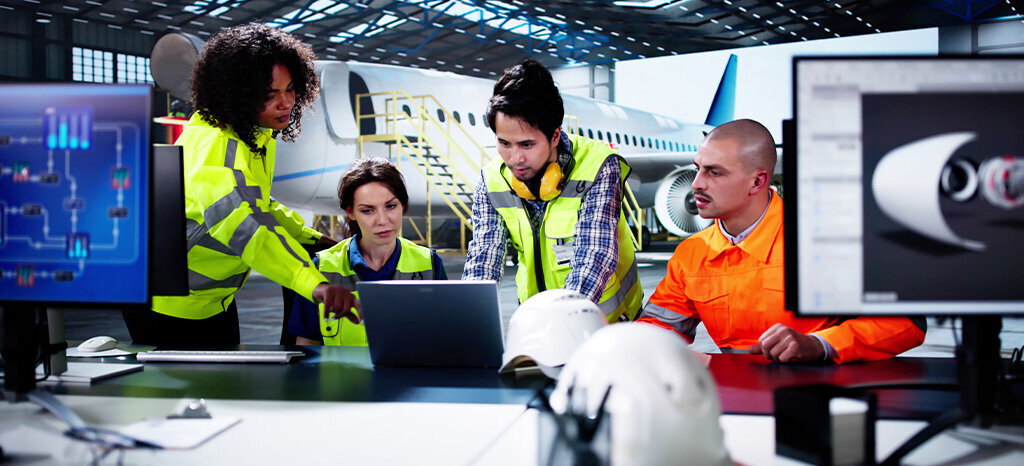
“Aviation in itself is not inherently dangerous. But to an even greater degree than the sea, it is terribly unforgiving of any carelessness, incapacity or neglect.” –Captain A. G. Lamplugh, 1931 – Former Chief Underwriter and Surveyor at British Aviation Insurance Company (the predecessor to Global Aerospace Underwriting Managers Ltd)
Everyone has a legal duty to behave in a responsible manner towards others. Those who fail to do so will be legally obliged to compensate a third party who suffers injury, death or whose property is damaged as a result of their action.
The aerospace sector is no different and consists of a wide range of businesses, including manufacturers and maintenance providers, that all have potential exposure to product liability in aerospace claims if it is proven their product or servicing of a product affected an aircraft’s performance, causing an accident that results in a claim.
Why Aerospace Suppliers Face Growing Legal Exposure
Product liability laws can be applied to any organisation that operates within the supply chain: airframe designers/manufacturers, component manufacturers, wholesalers/retailers, distributors and repairers. If an accident is attributed to a component part, a product manufacturer could be brought into a lawsuit. In today’s increasingly litigious environment, lawyers will call on all stakeholders that supplied parts or touched an aircraft in any way and include them within legal proceedings.
Even in the absence of negligence, the cost of defending against the claim or suit can be extremely substantial for a manufacturer. It is also worth noting that passenger aircraft accidents command worldwide publicity, generating significant attention in the news or social media with great potential to damage the reputation of operators and manufacturers. Whilst it is difficult to determine what an average settlement for a wrongful death lawsuit is, given all circumstances of a case differ, there is potential for substantial liability awards.
One of the most important functions of risk management in aviation is to identify any risks your company might be exposed to and then mitigate or eliminate that risk. Insurance risk managers will try mitigating this “products hazard” by use of various risk transfer mechanisms.
A company may manage and control that risk by limiting liability contractually or other similar means, but typically a risk manager will choose to purchase an aircraft product insurance policy to cover damages arising out of this products hazard. In addition to bodily injury or property damage caused by the failure of a component, it can also extend to include grounding liability cover, which covers the possibility of aircraft of a particular type being grounded by a relevant aviation authority following an incident.
What Is Aviation Product Liability Insurance?
From an aircraft insurance coverage perspective, an aviation product means a completed aircraft and any article forming part thereof, or supplied for installation in, or for use in connection with, or for spare parts for, an aircraft. This includes ground handling tools, training aids, instructions, manuals, engineering or other data or any article in respect of which engineering or other advice and services and labour have been given or supplied by the insured in connection with an aircraft.
An aircraft product is very wide ranging, with varying degrees of criticality. For example, a large structural part of a wing; a small screw or bracket used in a passenger tray table; chemicals used in the composite structure of an aircraft; fabric incorporated into the aircraft seats or electronic devices/wires used in the in-flight entertainment systems.
Each of these products has the potential to cause varying degrees of damage or injury. A failed wing structure is likely to cause a catastrophic air disaster, a faulty tray table could cause hot coffee to scald a passenger during a flight and faulty wiring has the potential to cause a fire.
In aviation, a company that makes wing panels or engine blades understands their product is destined for an aircraft and the risk of liability arising out of the failure of those products is high. However, as we have seen above, the product definition is very broad and could cause coverage issues for many products you would normally not think are aircraft related but become an aircraft product when incorporated into an aircraft.
It’s quite common that products are used for a purpose not necessarily intended by the original manufacturer. If the product becomes part of or is used in conjunction with aircraft, the manufacturer could potentially face the risk of liability arising from a catastrophic event resulting in substantial costs. It’s not inconceivable that a post-loss investigation reveals that the cause of an aircraft crash was attributable to a small subcomponent utilised in the manufacture of the aircraft.
This aviation supply chain risk is magnified and inherently higher in today’s production of modern aircraft. Traditionally, OEMs (original equipment manufacturers) built much, if not all, of their products themselves. Today, OEMs have increasingly become part integrators, utilising parts sourced from various entities in the chain rather than complete aircraft manufacturers.
Subcomponent manufacturers sell their products upstream to prime contractors who integrate them into larger components or systems, which in turn are sold to aircraft OEMs and subsequently assembled into a completed aircraft ready for delivery. Whilst aviation companies who make larger components or systems, such as engines or landing gears, have a clear understanding that their products are used in aircraft and can identify and manage the associated risks, some subcomponent manufacturers may not even know that their product is destined to be used in aircraft.
How To Protect Your Company With the Right Insurance Policy
The scenario described above is particularly problematic for manufacturers of generic products that end up in aircraft, without knowledge to the company itself. If a manufacturer does not purchase aerospace product liability insurance and a loss arises out of the use of a product in an aircraft related application, it is unlikely their CGL (commercial general liability aviation insurance) will respond to a loss. Without further insurance coverage, the potential exposure is high and threatens a company’s future existence. Is that a risk worth taking?
In addition, prime and lower-tier contractors no longer want to assume liability of third parties and are increasingly pushing liability on to their lower-tiered suppliers, removing the financial protection historically provided. This is leaving smaller companies significantly exposed against a large loss and is a scenario a risk manager should avoid. As such, aviation manufacturing insurance is imperative for any entity involved knowingly or unknowingly in the aviation industry, whether it be a manufacturing a small widget, designing a component part or servicing an engine.
Why Purchase an Aviation Products Liability Insurance Policy?
- General liability policies typically do not cover aviation related exposure.
- A fault in one component supplied to the aviation industry has the potential to cause a catastrophic event and incur substantial unforeseen legal liability.
- Aviation claims are often complex and may not be discovered until years after an event.
- Coverage is afforded for claimants’ costs and expenses associated with the claim (excluding any fines or penalties).
- The Insured’s legal cost and expenses incurred in taking legal advice and defending an action, even if the company was not the cause of the alleged injury or damage, can be substantial.
A failure to do so, and aviation can be terribly unforgiving of carelessness, incapacity or neglect.
Frequently Asked Questions (FAQ)
Why do aerospace manufacturers need product liability insurance?
Aerospace manufacturers need this insurance because a single faulty component can lead to a catastrophic event, resulting in substantial legal liability. Even if a manufacturer is not at fault, the legal defense costs can be immense. With the complexity of modern supply chains and the strict liability laws in aviation, this insurance is critical for financial protection.
What is aviation product liability insurance?
It is a specialized insurance policy that protects businesses in the aerospace supply chain from claims arising from third-party bodily injury or property damage caused by their products. It can cover everything from the completed aircraft to any component, part or even service supplied for use in connection with an aircraft.
What are the risks of supplying aircraft components without insurance?
The primary risks are facing crippling legal defense costs and potentially massive liability awards from a lawsuit, even if your company is ultimately found not to be at fault. Standard commercial general liability policies typically exclude aviation-related incidents, leaving your company’s assets completely exposed.
My company makes a generic component that might end up in an aircraft without my knowledge. Do I still need insurance for generic products used in aircraft?
Yes. Even if you are unaware that your product is being used in aviation, you can still be named in a lawsuit if that product is implicated in an aircraft incident. The risk of aircraft component liability exists regardless of your knowledge of the product’s final application, making insurance a vital safeguard.
How has the modern aviation supply chain increased product liability exposure in aviation supply chains?
Modern aircraft are assembled using components from a vast and complex global supply chain. OEMs act more as integrators than manufacturers. This means liability is spread across numerous suppliers. Prime contractors are also increasingly pushing liability down to their sub-tier suppliers, increasing the exposure for smaller companies in the chain.
Who is liable if a single aircraft component fails?
Following an incident, lawyers will typically pursue legal action against every company in the supply chain connected to the failed component. This can include the component designer, manufacturer, distributor and maintenance provider.
About Global Aerospace
Global Aerospace has a century of experience and powerful passion for providing aviation insurance solutions that protect industry stakeholders and empower the industry to thrive. With financial stability from a pool of the world’s foremost capital, we leverage innovative ideas, advanced technology and a powerful synergy among diverse team members to underwrite and process claims for the many risks our clients face. Headquartered in the UK, we have offices in Canada, France, Germany and throughout the United States. Learn more at https://www.global-aero.com/
Global Aerospace Media Contact
Suzanne Keneally
Vice President, Group Head of Communications
+1 973-490-8588
Source: Prodigy.press
Release ID: 1743039






